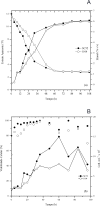Cocoa pulp in beer production: Applicability and fermentative process performance
- PMID: 28419110
- PMCID: PMC5395165
- DOI: 10.1371/journal.pone.0175677
Cocoa pulp in beer production: Applicability and fermentative process performance
Abstract
This work evaluated the effect of cocoa pulp as a malt adjunct on the parameters of fermentation for beer production on a pilot scale. For this purpose, yeast isolated from the spontaneous fermentation of cachaça (SC52), belonging to the strain bank of the State University of Feira de Santana-Ba (Brazil), and a commercial strain of ale yeast (Safale S-04 Belgium) were used. The beer produced was subjected to acceptance and purchase intention tests for sensorial analysis. At the beginning of fermentation, 30% cocoa pulp (adjunct) was added to the wort at 12°P concentration. The production of beer on a pilot scale was carried out in a bioreactor with a 100-liter capacity, a usable volume of 60 liters, a temperature of 22°C and a fermentation time of 96 hours. The fermentation parameters evaluated were consumption of fermentable sugars and production of ethanol, glycerol and esters. The beer produced using the adjunct and yeast SC52 showed better fermentation performance and better acceptance according to sensorial analysis.
Conflict of interest statement
Figures







Similar articles
-
Potential Applicability of Cocoa Pulp (Theobroma cacao L) as an Adjunct for Beer Production.ScientificWorldJournal. 2020 Sep 2;2020:3192585. doi: 10.1155/2020/3192585. eCollection 2020. ScientificWorldJournal. 2020. PMID: 32934606 Free PMC article.
-
Aroma-active ester profile of ale beer produced under different fermentation and nutritional conditions.J Biosci Bioeng. 2014 Jan;117(1):57-64. doi: 10.1016/j.jbiosc.2013.06.002. Epub 2013 Jul 9. J Biosci Bioeng. 2014. PMID: 23845914
-
Cachaça yeast strains: alternative starters to produce beer and bioethanol.Antonie Van Leeuwenhoek. 2018 Oct;111(10):1749-1766. doi: 10.1007/s10482-018-1063-3. Epub 2018 Apr 16. Antonie Van Leeuwenhoek. 2018. PMID: 29663103
-
Scale-down/scale-up studies leading to improved commercial beer fermentation.Biotechnol J. 2011 Aug;6(8):911-25. doi: 10.1002/biot.201000414. Epub 2011 Jul 11. Biotechnol J. 2011. PMID: 21744501 Review.
-
Studies supporting the use of mechanical mixing in large scale beer fermentations.Biotechnol Lett. 2010 May;32(5):623-33. doi: 10.1007/s10529-010-0213-0. Epub 2010 Feb 4. Biotechnol Lett. 2010. PMID: 20131078 Review.
Cited by
-
Optimization of a craft ale-type beer enriched with cañihua malt (Chenopodium pallidicaule) and banana passionfruit juice (Passiflora tripartita var. mollisima).Heliyon. 2025 Feb 10;11(4):e42610. doi: 10.1016/j.heliyon.2025.e42610. eCollection 2025 Feb 28. Heliyon. 2025. PMID: 40083986 Free PMC article.
-
A Review on the Obtaining of Functional Beers by Addition of Non-Cereal Adjuncts Rich in Antioxidant Compounds.Antioxidants (Basel). 2021 Aug 24;10(9):1332. doi: 10.3390/antiox10091332. Antioxidants (Basel). 2021. PMID: 34572969 Free PMC article. Review.
-
Autochthonous Biological Resources for the Production of Regional Craft Beers: Exploring Possible Contributions of Cereals, Hops, Microbes, and Other Ingredients.Foods. 2021 Aug 7;10(8):1831. doi: 10.3390/foods10081831. Foods. 2021. PMID: 34441608 Free PMC article. Review.
-
Potential Applicability of Cocoa Pulp (Theobroma cacao L) as an Adjunct for Beer Production.ScientificWorldJournal. 2020 Sep 2;2020:3192585. doi: 10.1155/2020/3192585. eCollection 2020. ScientificWorldJournal. 2020. PMID: 32934606 Free PMC article.
-
Investigation of aromatic compounds and olfactory profiles in cocoa pulp fermentation using yeast-based starters: A Volatilomics and machine learning approach.Food Chem X. 2025 Feb 25;26:102315. doi: 10.1016/j.fochx.2025.102315. eCollection 2025 Feb. Food Chem X. 2025. PMID: 40104613 Free PMC article.
References
-
- Briggs DE, Boulton CA, Brookes PA, Stevens R. Brewing: Science and Practice. Cambridge: CRC Press; 2004; 881p.
-
- Stewart GG. High gravity brewing, the pros and cons. New Food. 2007; 1: 42–46.
-
- Alves Z, Melo A, Figueiredo AR, Coimbra MA, Gomes AC, Rocha SM. Exploring the Saccharomyces cerevisiae Volatile Metabolome: Indigenous versus commercial strains. PLoS One. 2015; 24;10(11):e0143641 doi: 10.1371/journal.pone.0143641 - DOI - PMC - PubMed
-
- Lodolo EJ, Kock LF, Axcell BC, Brooks M. The yeast Saccharomyces cerevisiae the main character in beer brewing. FEMS Yeast Res. 2008; 8(7): 1018–1036. doi: 10.1111/j.1567-1364.2008.00433.x - DOI - PubMed
-
- Silva GC, Silva AAS, Silva LSN, Godoy RLO, Nogueira LC, Quitério SL et al. (2015) Method development by GC–ECD and HS-SPME–GC–MS for beer volatile analysis. Food Chemistry. 167: p. 71–77. doi: 10.1016/j.foodchem.2014.06.033 - DOI - PubMed
MeSH terms
Substances
LinkOut - more resources
Full Text Sources
Other Literature Sources
Molecular Biology Databases

